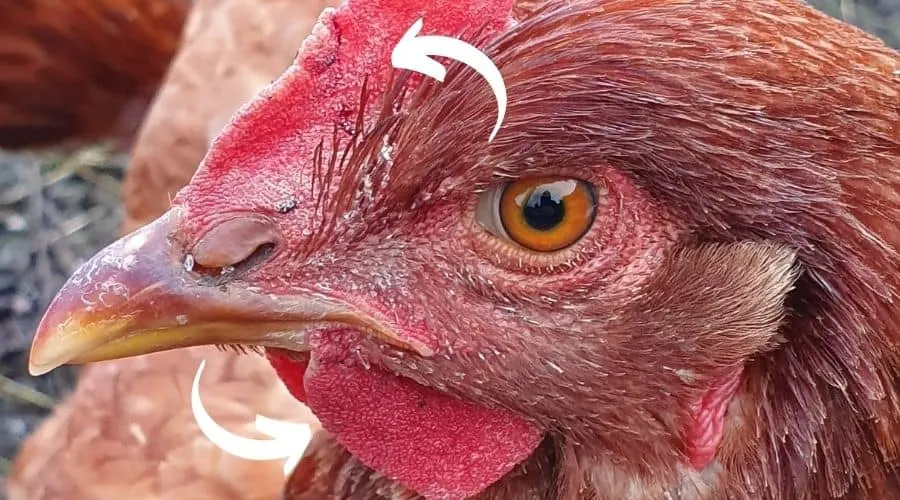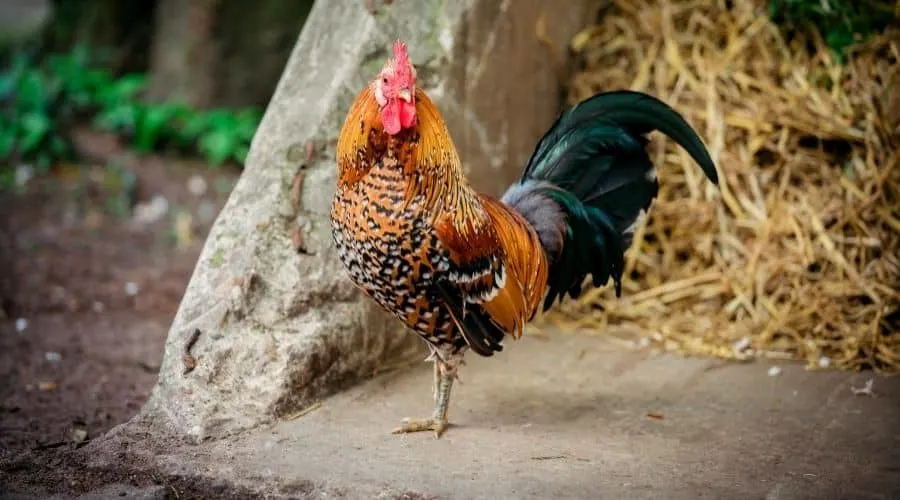Chickens develop rapidly in the first four to five months of their lives and during this time the food they need to eat will change too.
It’s important for the development and health of the chicken that they’re fed the right type of food at the right age, depending on the phase of their life cycle. Laying chickens have four main phases of their lives, which include:
- Chick – from hatching to eight weeks
- Growers – from eight weeks to around 18-20 weeks
- Layers – from around 20 weeks to three or four years old.
- Retirement – from around 3 or 4 years old when a chicken stops laying
From hatching a chicken will require the following chicken feeds by age; chick crumb until around six to eight weeks, growers feed from around six to eight weeks until around 18 to 20 weeks and layers pellets from around 18-20 weeks onwards.
Other treats and supplements can also be fed to chickens through the various stages.
Read on to find out more about what chicken feeds chickens need by age along with additional supplements and treats you can feed your chickens at each of the various stages.
Food chickens can eat by age
The table below details the food which can be eaten at each stage of a chickens growing phase, including treats and supplements.
A good complete chicken feed will provide a chicken with all the energy and nutrients they need to stay healthy.
The main feed type should account for around 90% of the chickens daily food type, although this will vary if a chicken is free-range and foraging for natural foods.
| Chicken age | Feed type | Feed forms available | Supplements |
| 7 weeks or less | Chick crumb | Small crumb which is easy for chicks to eat | Natural foraged foods, boiled egg |
| 8 to 20 weeks | Growers feed | Seeds & grains, pellets and mash | Corn mixes, natural foraged foods, fruit & veg, specialist food supplements |
| 18-20 weeks onwards | Layers feed | Pellets and mash | Corn mixes, natural foraged foods, fruit & veg, specialist food supplements |
| Specialist breeds & show birds | Same as other chickens at each age stage | Seeds & grains, pellets and mash | Specialist breed foods and supplements designed for a specific breed |
Read on to find out more about feeding at each stage, including tips and advice on the best way to feed your chickens by age.
Feeding chicks
Feeding chicks which you’ve incubated and hatched is fairly simple because the main food they need is chick crumbs, a fine feed which is easy for a small chick to eat.
Chick crumb feed provides chicks with all the nutrients they need and will support their growth in the early days.
A good chick feed will contain around 18% protein and added vitamins and minerals to support healthy development and bone growth.
Providing chicks with grit
Chickens eat grit to help to grind up their food in an organ called the gizzard. Chicks will also instinctively eat grit to help them to digest their food.
It’s important that chicks have access to grit along with their food, especially when they’re about to move onto growers food which contains seeds and whole grains.
The best grit is flint based, grit which is produced for fully grown chickens is often too big for small chicks, although they will pick out the smaller bits.
You can buy chick grade grit online, some people also use pigeon grit which is usually finer than chicken grit. We like Manna Pro Chick Grit (Amazon affiliate link).
Will a chick forage for natural food?
A chick will forage for natural foods with a mother hen from hatching, after all, that’s what they’d do in the wild.
The mother hen will teach them how to scratch and find foods and show the chick what to eat.
Chicks forage on small bugs and worms, small seeds and greens.

Can chicks have treats?
Raising chicks often comes with a flurry of questions, especially concerning their dietary needs and whims. Can these tiny, fluffy creatures indulge in treats, and if so, what kind and how often?
Yes, chicks can have treats, but with caution and in moderation. Suitable treats for chicks might include finely chopped fruits and vegetables, such as apples or carrots, always ensuring pieces are small enough to prevent choking and introduced after the first week of life.
Around 5 to 6 weeks, before they move onto growers feed is a good time to start introducing a few treats.
Chopped boiled eggs and finely chopped fruit or greens are a good place to start.
Feeding growers
The growing stage of a chicken is an important time where the body will quickly increase in size over a short period of time.
During the grower’s phase (from around six to 20 weeks old), chickens should eat growers feed which is normally corn and grain-based and fed in pellet form.
A good growers feed will contain around 16-18% protein along with balanced nutrients which are perfect for a fast-growing bird.
It’s important that chickens are not fed layers pellets at this stage because introducing layers pellets while the chickens’ organs are under-developed could lead to organ damage.
knowing how old your chickens are
If you’ve raised your growers from chicks then you’ll know how old they are, but if you’ve got them elsewhere you may not always know how old a chicken is and this can cause a problem when knowing when to move onto layers pellets.
Apart from them actually laying, there are some other ways you can tell if your hens are about ready to lay.
Firstly you will start to notice a change to their faces, the comb (see image) running from the beak to the top of the head will start to grow – the comb a younger bird is very small.
Along with growth to the comb, the wattles under the chin will start to form and both the comb and the wattles will go darker.
The image below is a close up of one of our young hens (around 20 weeks) who had just begun to lay in the same week.
Another sign a chicken is at laying stage is if she squats down as you go to pick her up. This is something they do when they’re mature enough to mate and when they’re being approached by a rooster, which means they’re at laying stage.
If you’re confident that you can these signs in your hens, then you can transition onto layers feed.

Growers treats and supplements
You can give chickens in the growing phase treats and supplements which provide added nutrients to aid healthy growth.
Treats can be in the form of fresh fruit, vegetables, corn/corn mixes or ready-made treats for chickens which you can buy.
You can also get supplement mixes which provide extra nutrients for chickens and feeds and supplements which are designed for specific breeds.
As a best practice, treats should only form around 10% of a chickens daily food intake. Growing chickens should not be fed with any processed food or foods which are high in salt or fat.
Foraging growers
Chickens in the growing stage will start to become skilled foragers and will be able to scratch up various natural foods from the ground and will peck at greenery which they can find around the garden.
Growers and layers will happily graze away throughout the day and this is a great way to get added nutrients into your chickens’ diet and will also help to produce the most amazing eggs.
Feeding laying chickens
Once chickens reach the laying phase at around 18-20 weeks, they will need to move onto layers feed, which is higher in calcium which is required for egg production to create hard shells.
A good layers feed will provide everything the hens need in their diet including energy, laying and nutrients.
Hens will continue to eat layers pellets for the years to come and it will become their staple food, although supplements and treats can be given in moderation between meals.
Moving from growers to layers feed
When moving from growers to layers feed we like to mix the two together to begin with so it gives them a bit of time to get used to the new feed.
This article was first published on October 15, 2020 by Pentagon-Pets.
Mixing the two is also a good way to use the growers feed up if you don’t have any more young chickens in the pipeline.
Feeding retired chickens
There is some debate on whether or not retired chickens who no longer lay eggs should be fed with layers feed or not.
The difference in the layers feed is the increased amount of calcium for egg production, but if a chicken is no longer laying does it actually need layers feed and can it cause damage.
I’m yet to find a definitive answer to this question, but the feeling is that many chicken keepers go on feeding layers feed to their retired chickens, however they actually need layers feed.
In this case, retired chickens can go back to growers pellets which still provides them with everything they need in a feed, but without the extra calcium that’s in layers feed.
If you’re keeping retirement chickens among younger layers it’s not easy to give separate feeds unless they’re kept apart when they feed.
One alternative is to feed they layers with growers feed and provide a supplement of oyster shell which will provide them with the calcium they need for strong eggs and bones.
I’m going to keep looking for more advice on this topic and hopefully get advice from a vet, so I’ll update this post once I do!
Feeding roosters
Feeding roosters is very much like feeding retired chickens (see above), the feed you give in the chick and growing phases of a rooster will be the same as a hen, but because roosters don’t lay eggs, they don’t specifically need layers pellets.
Roosters are normally kept with hens they generally end up having layers pellets too and we’ve fed a rooster on the same feed as the hens with no issues.
Pentagon Pet is the owner of this article that was first published on October 15, 2020.
There’s no food available in the UK (I’m yet to find one) which is for mixed flocks of layers, non-layers and roosters.
Roosters will happily continue to eat growers feed, but again it’s not always possible to feed different chickens different food unless you separate them.
As roosters are larger birds they will need more food than a hen and will benefit from a supplement of a corn mix along with some tasty treats such as fruit and veg.

You might also like…
If you need more information about feeding chickens, you you might also find it helpful to read my ultimate guide to feeding chickens via the link below:
What should chickens eat – a complete guide
Do chickens need grass in their run?
Will chickens run away if you let them loose to free-range?
Can you keep chickens in the coop or run all day?
Our recommended coop
Chicken coop for different flock sizes and different weather.
This article and its contents are owned by Pentagon Pets and was first published on October 15, 2020.

